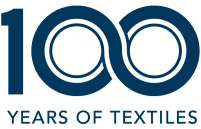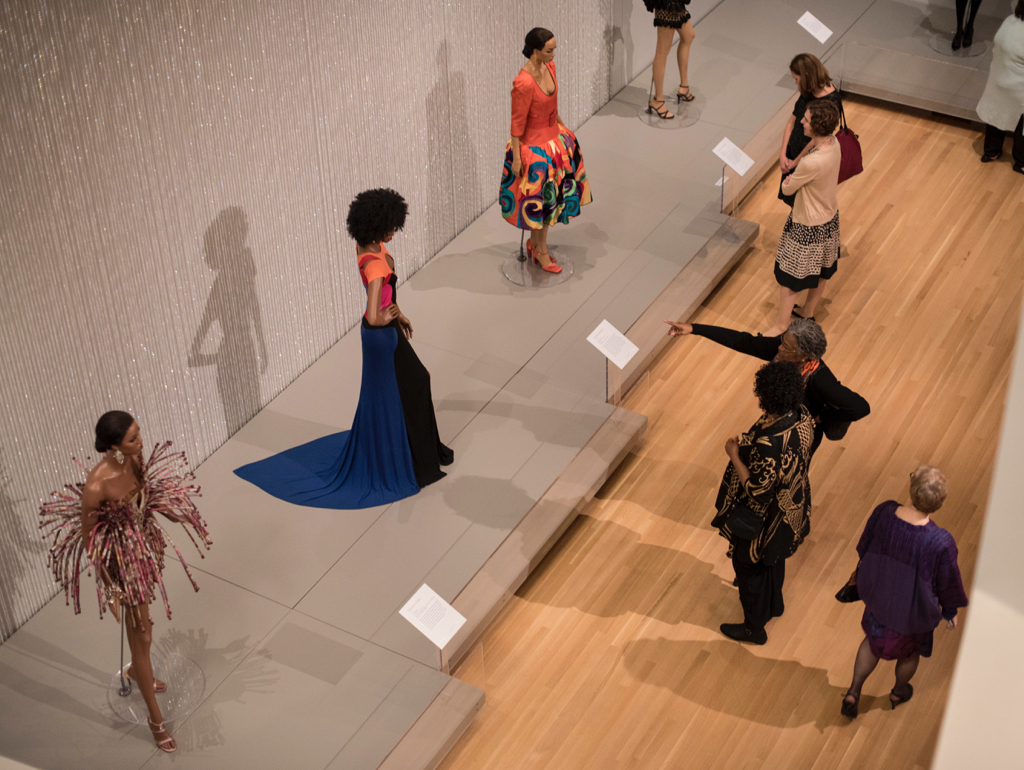MEDIA CONTACTS:
Brett Zongker: bzongker gwu [dot] edu, 202-994-6466
gwu [dot] edu, 202-994-6466
Maralee Csellar: csellar gwu [dot] edu, 202-994-7564
gwu [dot] edu, 202-994-7564
WASHINGTON (March 16, 2017)—For 50 years, the Ebony Fashion Fair shaped a new vision of black America through contemporary fashion. Founded by Eunice Walker Johnson in 1958, the traveling fashion show broke the color barrier to bring the pinnacle of global fashion to communities that were eager to celebrate black accomplishment, aspiration and success.
The George Washington University Museum and The Textile Museum will present the story of the Ebony Fashion Fair and its cultural impact with the new exhibition “Inspiring Beauty: 50 Years of Ebony Fashion Fair.” Forty garments selected from a collection of thousands are at the center of this dynamic show—including stunning gowns, feathered coats and statement designs by Christian Dior, Vivienne Westwood and burgeoning designer Naeem Khan, who would go on to dress first lady Michelle Obama.
“The exhibition provides a unique opportunity to see how the Ebony Fashion Fair was an important part of the black experience for 50 years,” said Camille Ann Brewer, curator of contemporary art at the George Washington University Museum and The Textile Museum. "The fair was an important annual cultural event and fundraiser in the Washington, D.C. area, with Washington being one of the three largest venues in the U.S."
Ebony Fashion Fair was the first fashion show to introduce black models to the runway. The exhibition includes nearly 100 objects, including ensembles, accessories and videos, to help recreate the Fashion Fair experience. Ms. Johnson’s exquisite personal style and her influence in the world of fashion are explored through archival images, invitations to fashion houses and interviews with former stylists and attendees of the Fashion Fair.
Organized by the Chicago History Museum in cooperation with Johnson Publishing Company, which published Ebony and Jet magazines and produced the Fashion Fair, “Inspiring Beauty” is the first-ever exhibition about the show. The exhibition opens Saturday and will be on view through July 24.
A Brief History of Ebony Fashion Fair
The Fashion Fair began in 1958, and over the next 50 years, the traveling show blossomed into an American institution that raised millions for charity and helped Johnson Publishing Company reach its audience.
Fashion Fair was originally the name of a section in Ebony magazine. It became a fashion show under Ms. Johnson’s direction. She gained access to the highest echelons of fashion design, which at the time excluded African-Americans, and she shared that access with her audience.
Traveling throughout the United States, Canada and the Caribbean, the Fashion Fair provided a unique forum for audiences to experience the world’s best fashion, showcasing designs by Italian, French, British, Japanese and American designers. In constant struggle to break the color barrier in fashion, the show provided a platform for African-American models as well as black designers who were featured alongside the world’s leading fashion houses.
The Exhibition
“Inspiring Beauty” is presented in three sections that explore three themes. The first section, “Vision,” explores Ms. Johnson’s role as the creative force behind the Fashion Fair. It features costumes that reflect power, affluence and influence and those that express some of the traveling show’s recurring aesthetic ideas. Highlights include a 1996 Bill Blass three-piece houndstooth ensemble; the 1986 “I (heart) Fashion Scandal” jersey dress by Patrick Kelley, a design commissioned by Ms. Johnson for that year’s fair; and a 2000 Fausto Sarli canary yellow beaded cocktail suit.
The second section of the exhibition, “Innovation,” looks at the boldness and experimentation of Johnson Publishing Company. This is explored through videos and ensembles that feature bold stylization, dynamic shapes and innovative techniques. Garments in this section reflect the full breadth of fashion fantasy that the traveling show brought audiences.
The final section, “Power,” features the exhibition’s most elaborate, luxurious and dramatic ensembles. Costumes by designers like Valentino, Bob Mackie, Henry Jackson and Alexander McQueen—all before the designers reached world-renowned status and dressed fashion icons such as Mrs. Obama—reflect the glamour and showmanship that created the dynamic visual experience that audiences came to expect. Like the traditional finale of haute couture runway shows, Fashion Fair always closed with a magnificent bridal gown. Emanuel Ungaro’s 18th-century-inspired wedding gown comprised of a beaded lace bodice, lavish pannier-style skirt embellished with embroidered floral sprays and an underskirt of painted lace makes a dazzling final impression.
“Inspiring Beauty: 50 Years of Ebony Fashion Fair” is presented by the Costume Council of the Chicago History Museum and toured by International Arts and Artists Washington, D.C. Joy Bivins, curator at the Chicago History Museum, and Virginia Heaven, associate professor of fashion design at Columbia College Chicago, developed the exhibition.
Current Exhibitions
"A Collector’s Vision: Creating the Albert H. Small Washingtoniana Collection" presents highlights from the Albert H. Small Washingtoniana Collection, including his first acquisition and other items that explore what motivates an individual to collect. Mr. Small, a third-generation Washingtonian, first became interested in historical collecting after serving in the Navy during World War II. In 2011, Mr. Small donated his unrivaled Washingtoniana collection—nearly 60 years in the making—to GW. This collection documents the formation, development and history of Washington from the 18th to the mid-20th century and includes 1,000 maps and prints, rare letters, photographs and drawings.
The exhibition “Your Next President . . . ! The Campaign Art of Mark and Rosalind Shenkman” looks back at the history of American presidential campaigning through rare 19th-century campaign flags and other patriotic textiles from the Mark and Rosalind Shenkman Collection. Additional pieces from the Albert H. Small Washingtoniana Collection broaden the story. The exhibition is open through April 9.
Visit the museum’s website for the latest information on exhibitions and educational programs: www.museum.gwu.edu.
-GW-



